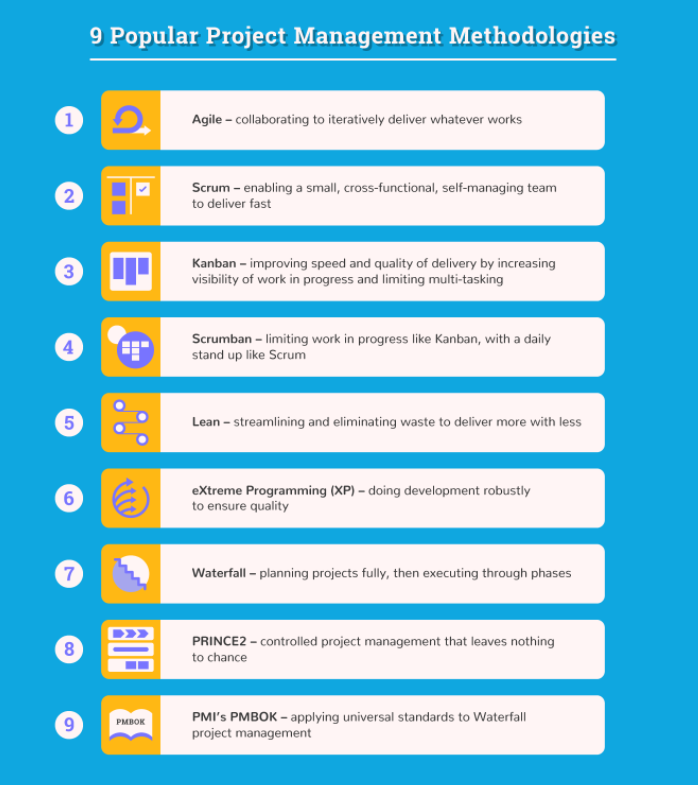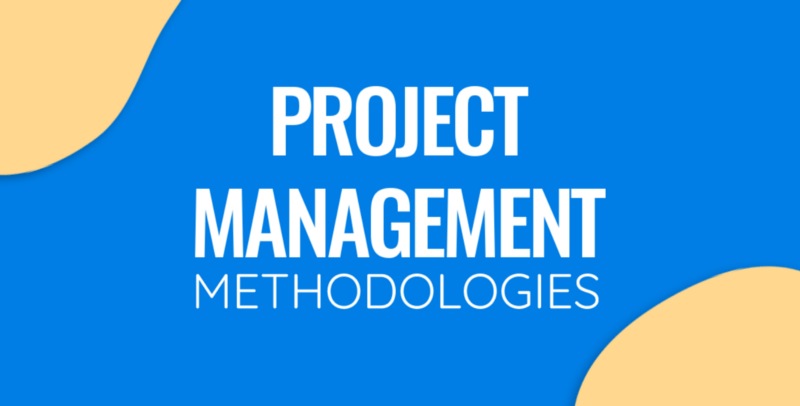Project Management Methodologies, and Frameworks – Complete Guide for Beginners
Managing a workforce can be complex. If you’re new to project management (PM), you might find yourself asking: what is project management methodology? Projects usually span across several team members — and even multiple teams in different locations, like freelancers or service providers. When tracking your costs on a large-scale project — say, developing an app or marketing campaign - you also need to factor in labor hours as well as material costs. But how do you manage a workforce effectively? This is where project management methodologies come into play. Project management methodologies are systems used by project managers to manage the workforce and keep track of their projects while ensuring they run smoothly. The most common project management methodologies include waterfall, agile, lean, and scrum. With the help of project management methodologies, you can efficiently organize all your tasks, personnel, and resources, and do the project budget tracking to ensure that everything stays on track throughout the course of your project. Let’s take a look at the top 10 most popular project management methodologies and frameworks today! The waterfall methodology is a traditional project management methodology. With waterfall, you’ll have one phase that flows into another. The phases are: Plan > Execute > Assess/Control > Close. Since it follows a top-down structure, each phase must be completed before moving on to subsequent phases. Because of its rigid structure, the waterfall is not flexible when compared to other project management methodologies. Therefore, some teams may need more time than others to complete projects under the waterfall. The agile methodology is used by project managers to achieve goals in a timely manner. This methodology focuses on time constraints as opposed to traditional (or phased) methodologies that include phases of goal development and completion, which can last anywhere from months to years. Under agile, the projects are finished when they meet their time constraints rather than upon reaching predetermined milestones. Kanban is another popular project management methodology that comes from Lean Manufacturing. Kanban is a visual system where you’re able to quickly identify what stage a task is in. The Kanban method includes creating work lanes (or columns) for To Do, In Progress, and Done tasks. Once complete, these items are moved from column to column as they go through the lifecycle of your project workflow process. The Scrum methodology, which emphasizes the iterative and incremental approach, has made a lot of waves in recent years since it is much more manageable. Scrum methodology is also popular because it allows project managers to make changes easily as new information becomes available. That is why it is more adaptable and flexible and delivers value to the customers throughout the project development. In the modern world, we all want to leverage the best of technology and manpower to get the maximum and most essential output from a project. The Primavera P6 framework is in widespread use today. It was first developed by P3 corporation, now part of Oracle Corporation; it’s primarily used as a standalone application rather than a component of another system. It is based on concepts such as Gantt charts, resource allocation, and critical path analysis — all useful techniques to keep projects on track. It also uses other tools to help teams manage their work more effectively: including cost-tracking tools and scheduling templates.Top 9 Project Management Methodologies and Frameworks
Waterfall/Traditional Methodology
Agile Methodology
Kanban Methodology
Scrum Methodology
Primavera P6 Framework
Share your project details to build your path toward success.
Critical Chain Project Management
The critical chain uses a network view of a project. Every activity is a link in a chain, critical or non-critical. It is not a new concept; it can be traced back to many past managers such as Henry Gantt (father of work breakdown structure), Eliyahu M. Goldratt (creator of project management theory: Theory of Constraints), Dr. Eliyahu M. Goldratt, Danilin and Mani Srivastava. This technique assumes that every project has both critical path activities and schedule buffers, which will absorb any delays caused by other activities along its path. This means that no delay can cause any project milestone to slip by more than one day. This approach provides tools to help us achieve shorter schedules while maintaining quality.
Failure Mode and Effects Analysis (FMEA)
When examining potential risk areas within a project management plan and overall business strategy, failure mode and effects analysis (FMEA) is a powerful method of cost analysis. With FMEA you assign value to every single risk area in your process and therefore are able to prioritize with ease. It also helps you prepare mitigation strategies and be better prepared to deal with issues as they arise. Using it will help you complete your project without fail.
Adaptive Project Framework
The adaptive project framework (APF) is one of the most comprehensive project management methodologies available. It was designed by a group of experts in 1998 with over 50 years of combined experience. In fact, it was created because they were dissatisfied with other frameworks at that time. The name adaptive comes from its ability to adjust itself as circumstances change. It helps you plan your projects in an organized manner. This methodology is extremely flexible, allowing you to create custom processes and steps based on your needs. And even if you don’t need all those steps right away, you can always add them later on.
Lean Methodology
The Lean methodology began as a manufacturing strategy to improve efficiency. It was then adopted by software companies in an effort to streamline productivity. Today, it is used in nearly every industry. According to The Global Institute of Project Management (GIPM), Lean project management has its origins in Toyota’s ‘Just-in-Time’ production system. Essentially, it is a method that focuses on reducing waste throughout all stages of development: from planning to execution.
PRINCE2
The PRINCE2 methodology is a structured project management methodology. It comprises PRINCE2 itself — a set of core practices and integrated processes; several optional aspects (e.g., PRINCE2 Agile) — one or more selected approaches to fulfilling project needs based on the main body of work described in PRINCE2; together with a comprehensive knowledge package that covers topics such as risk management and quality assurance.
A project using PRINCE2 consists of three phases: Initiation, which defines requirements for projects and produces a project brief; Planning, which determines how requirements will be met; and Control, which monitors progress towards meeting those requirements. A fourth phase — Closing — completes all remaining tasks once delivery has been made. This part should talk about — Project Planning> All projects have some form of planning process associated with them that identifies deliverables and ensures they are completed within time frames specified by project budgeting.
How to Choose the Best Project Management Methodology for your Business?
There are several project management methodologies to choose from. While some may be more popular than others, it’s important to pick the one that works best for your situation. Here’s a complete guide on how to choose the right project management methodology.
Check how Simple or Complex or Project Is
If you’re working on a simple project, there isn’t much point in using something complex like PRINCE2 or Six Sigma. If you have several different teams working together simultaneously (as in Agile), you might want to consider using a hybrid approach like Scrum+Kanban or Waterfall+Agile.
Project Budget Tracking
Another thing to keep in mind is project budgeting: which management framework will be right for your budget? A very expensive methodology may not be worth it if your project is small-scale.
Prefer a more Adaptable Methodology
You should also keep in mind that most methodologies can be adapted and customized — and that some of them are more flexible than others. For example, while PRINCE2 has a reputation for being rigid, it can actually be quite adaptable depending on your specific needs as an organization.
What Does It Take to Manage a Workforce?
Managing a workforce is a part of project management that often gets overlooked. Many business owners fail to understand how to manage workers effectively. The process should be easy — give everyone clear instructions on:
- What they need to do,
- When they need to do it by, and
- How it’s supposed to be done (and then check upon them).
There are two different ways you can go about managing your workforce: being in control or letting people do their jobs.
CrowdWriter UK believes in administering assistance to help learners to achieve their career goals.
The best way to manage a workforce is through collaboration and communication. It’s important to remember that each person working on your project has their own job description but also knows how they fit into the bigger picture.
Workforce analytics also plays a crucial role in managing the workforce. It can enable employees to quickly locate project managers who are available and qualified to take on new assignments. In addition, these programs help managers assess staffing needs based on open projects’ characteristics. Employers can also track workforce analytics data over time — to identify trends in performance, including variances in workflow productivity. This type of information is valuable while doing project budgeting or conducting workforce planning.
To do this job accurately, several employee time trackers or time tracker apps are available in the market. They provide a comprehensive solution for tracking employee time spent on projects, which allows employers to more accurately predict project costs. This system allows employees to submit their hours using an online interface, making it easy for companies to stay organized while also saving money by reducing administrative costs.
The second benefit of a time-tracking system is its ability to assist in project budget tracking for resources and expenditures. This system can help you better manage workforce, by giving you insight into how much each project costs as well as how many hours each employee has worked on them.
One of the best employee time tracker apps with GPS nowadays is work status which is greatly used by the top companies to efficiently utilize their workforce.
What’s best is that they offer a 14-day FREE trial to make you understand how well it is helping your business grow.
Conclusion
Project Management is crucial to better manage the workforce and projects in order to keep costs low and ensure your profit margins remain high. You can streamline the management of your company with an efficient and effective project management methodology.
Under this blog, we have explored how project management can be beneficial for your business and how you can use it to maintain your budget and increase productivity in order to achieve your long-term goals.
We will keep covering some other useful topics for you and your business. Till then, stay tuned and share your valuable feedback with us in the comment section. You can also follow us on social media to stay updated with the latest technology trends.








